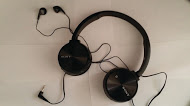Earphones or Headphones?

Headphones were developed 1910 by nathaniel Baldwin in Utah. He sold the first pair of headphones to the U.S Navy, who found them to be a vast improvement over the technology that Naval radio operators were using. After 30 years of the headphones release, Sony came up with the little earphones that fit in your ear to accompany the Walkman which were used in the late 1970s and early 80s. It reached its popularity in 2001 when Apple and Steve Jobs introduced the iPod and shipped each one with white earbuds. Headphones always have been a danger to our hearing, if you listen them too loudly for too long. The reason why earbuds can be a hazard sometimes is because the ears are delicate. When sound enters our ear, it causes the eardrum to vibrate. These vibrations will travel to the cochlea, where fluid carries them to tiny hairs that stimulate auditory nerve fibers that travel to the brain and interpret the sound. Hearing loss occurs when the hair cells inside our ears are destroyed. Earbuds can have a higher output of noise compared to regular headphones. Earbuds can have a higher output level of sound by about 7-9 decibels. Decibels is a unit used to measure the intensity of a sound. Most teens listen to music at 110-120 decibels. At this level, loud noise can cause permanent hearing loss after just an hour and 15 minutes. The number of teens with hearing loss has went 33 percent since 1994. When listening with earbuds, the American Auditory Society’s rule of thumb is 60/60 which means to not listen for more than 60 minutes at a time at 60 percent of the maximum volume. Another way to prevent hearing loss is to try using noise-canceling headphones. These headphones will help to block out surrounding sounds so there is less chances of having to turn up the sound.
